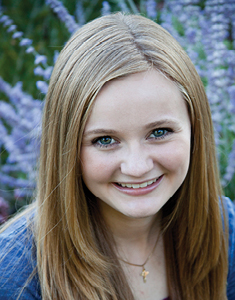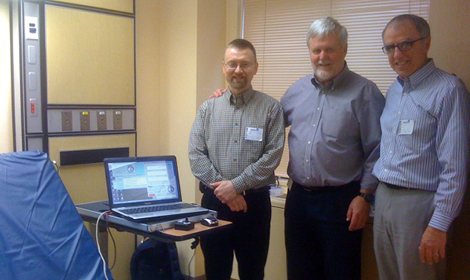A Father’s Formula

“How is managing diabetes like navigating an airplane?” That may sound like the beginning of a bad joke, but the answer resulted in a promising innovation in T1D treatment in JDRF’s current research portfolio.
Like many other parents of children with type 1 diabetes (T1D), Don Matheson is well versed in the latest research advances that may help his daughter live a longer, healthier life. And as an engineer, he understands the science behind those advances better than most. What he never expected, however, was that he might one day play a part in developing such a life-changing treatment himself. Don is now one of three founding partners in a biotechnology company called Dose Safety. The company’s goal? To fully automate blood-glucose testing and insulin dosing in a single, closed-loop treatment device—what we now call an artificial pancreas system.

When Don began his venture in 2002, he had no background in medicine or medical research. He was, in fact, in the middle of a successful career as a structural engineer at aircraft manufacturer Boeing. Three years earlier, when his four-year-old daughter, Laura, was diagnosed with T1D, Don and his wife, Anita, began learning everything they could about the disease. “We were determined to find out what the state of the art in treatment was,” says Don.
At that time, continuous glucose monitors (CGMs)—which automatically measure blood glucose with a subcutaneous (under the skin) sensor—were in development but not yet approved for use in the United States. Don’s engineering background led him to what he considered an obvious question—why were the researchers who were developing CGMs not working toward a “closed-loop” treatment system that would combine and automate the functionality of a CGM with that of an insulin infusion pump?
Don brought his question to various diabetes researchers, and found that they were on the same page. Many laboratories had envisioned such a closed-loop system—essentially an artificial pancreas system—“but they had all come up against the same obstacle,” he says. The problem, Don was informed, was in the control system that would analyze readings from the CGM and calculate an appropriate insulin dose in response. Any such control system must be able to analyze blood-glucose readings and past insulin usage and then safely and effectively determine the best next dose of insulin. For the control systems then being used, the inputs and variables of T1D were simply too unpredictable to manage with adequate safety or accuracy.
The right place, at the right time
Although it is often the case, not all medical breakthroughs begin in a laboratory or a research clinic. In fact, sometimes one can start in the unlikeliest of places. For Don, that unlikely place was a Boeing technical conference held in Seattle in February 2002. At a presentation by two Boeing software engineers—Suray Bhatia, Ph.D., and Robert C. Kircher Jr.—the proverbial light bulb lit up in Don’s head. He realized that the key to solving the control-system problem was being laid out in front of him—in the form of a technology called “fuzzy logic.”
Fuzzy logic is an extension of traditional, true-false logic, an approach that allows for a mathematical characterization of variables that are defined by uncertainty—variables such as those that affect blood-glucose levels. In the traditional logic paradigms that underlie much of the technology we interact with every day—personal computers, smartphones, traffic lights, television, etc.—variables have exact and opposite values: true and false, one and zero, on and off. Fuzzy logic variables, on the other hand, may take on values that are defined by an expert, such as an endocrinologist, and translate them into language understood by the computer. Additionally, “fuzzy logic takes a system that is poorly behaved mathematically and allows it to be well controlled,” says Bob Kircher, one of the two presenters at the Boeing conference. Fuzzy logic was developed in an academic field in the 1960s and has been used in such varying applications as camera technology, power-supply systems, earthquake prediction, and yes, aircraft control systems.
With a potential solution within his grasp, Don was more than motivated to get started on the problem. “I knew that, even if the technology didn’t yet exist, the expertise to create it did,” he says. And over the next few months, he gathered exactly the expertise he would need—the two men who are his partners at Dose Safety.
Richard (Rick) Mauseth, M.D., the pediatric endocrinologist who cared for Laura Matheson until her 18th birthday, serves as CEO and chief medical officer of Dose Safety. It is his expertise, honed over 35 years of medical practice, that provides judgment to the fuzzy-logic controller. Bob Kircher is vice president of engineering and regulatory affairs and is the chief programmer. And Don is vice president of data management and statistical analysis and provides testing expertise learned at Boeing.
Between them, Don and Bob have more than 50 years of aircraft engineering experience, and they describe striking similarities between airplanes and diabetes. “Both an airplane and an artificial pancreas system perform tasks on which lives depend,” says Don. And Bob: “When a plane takes off from Miami, which is at sea level and warm, and lands in Denver, a mile above sea level and much colder, the plane is operating with very different environmental factors in a short stretch of time. It has to be built to withstand those variables. Likewise, the insulin needs of a person with diabetes change all the time and are influenced by many factors.”

Although Dose Safety was originally a side endeavor for the three men—they all continued their regular jobs and worked with each other on nights and weekends—they moved quickly. Dose Safety launched clinical trials on its prototype algorithm, designed by Dr. Bhatia, in September 2003, just one year after the official launch of the project. In 2006 they filed a provisional patent of their fuzzy-logic controller. With the work developing at such an accelerated pace, in February 2012, Bob left Boeing and devoted himself full time to the work of Dose Safety.
Funding innovation, wherever it happens
It was at a Diabetes Technology Meeting in Bethesda, MD, in 2008 that Dose Safety found its first funding champion—JDRF. After attending a presentation on their fuzzy logic–based algorithm, Aaron J. Kowalski, Ph.D., currently JDRF’s vice president of treatment therapies, facilitated a collaboration between Dose Safety and Francis J. Doyle III, Ph.D., a diabetes researcher at the University of California, Santa Barbara, and Sansum Diabetes Research Institute who is also a member of JDRF’s Artificial Pancreas Project (APP) Consortium.
“JDRF is constantly looking for the best people in the world to work on diabetes research. Rick, Don, and Bob brought together world-class engineering and diabetes expertise. This was a perfect fit for our Artificial Pancreas Project,” says Dr. Kowalski.
With Dr. Doyle’s help, the Dose Safety team tested their control system in adults, teenagers, and children, using a simulator that models blood-glucose activity. From these tests, the researchers achieved two important goals: the maintenance of a safe average blood-glucose level and the minimization of hypoglycemia. By 2008 Dose Safety had filed a full patent.
The following year, JDRF awarded Dose Safety an Innovative Grant. The team continued its research, beginning their collaboration with Carla Greenbaum, M.D., director of the diabetes program at Benaroya Research Institute in Seattle. That same year, the partners submitted a poster and gave a presentation at the American Diabetes Association’s Annual Scientific Sessions, in Orlando, FL.
In 2011, JDRF’s confidence in the company was further affirmed when the men received a Small Business Innovation Research grant from the National Institutes of Health. And in 2012, JDRF provided an Industry Discovery and Development Partnership grant, to continue the development of the control system.
Dose Safety represents one component of the wider research strategy JDRF is pursuing through the Artificial Pancreas Project. Since 2006, when the APP Consortium was established, JDRF has funded both academic and industry researchers developing progressively more sophisticated approaches to the technology—from systems programmed to shut off the insulin to prevent hypoglycemia, to those that anticipate and prevent both hypo- and hyperglycemia, all the way to fully automated systems.
JDRF is also funding AP investigators employing different algorithmic approaches. “Through this funding strategy, we are accelerating our ability to eventually deliver an artificial pancreas system into the hands of people with type 1 diabetes,” says Marlon Pragnell, Ph.D., senior scientific program manager for glucose control therapies at JDRF. “We are really looking forward to seeing what Dose Safety achieves next.”
The human element
You could say that people with T1D run their own personal glucose-control “algorithms” all day, every day. People living with the disease learn to balance carbohydrate calculations, basal and bolus insulin injections, exercise, stress levels, and numerous other variables all in an effort to maintain blood-glucose level within an optimal range—and they do it continuously.
The founders of Dose Safety understood this when they developed the first iteration of their control system. They also understood that every individual with T1D responds a little differently to the numerous variables at play. So Dr. Bhatia’s first step in designing the algorithm was to exhaustively interview Dr. Mauseth about the hundreds of different ways that a person’s blood glucose might be affected in various situations—and what he, as a physician, would prescribe to treat it.
“The reason the Dose Safety controller is so intuitive is that it was designed on one essential question,” says Dr. Pragnell: “What would the expert physician do?”
The goal from the beginning has been to create a fully automated system, and the three partners have been fine-tuning and making more- and more-sophisticated improvements since day one. They are addressing issues including:
- eliminating the system’s response to “data noise” (essentially, erroneous readings) from the CGM;
- incorporating a “personalization factor” by which individual users can tune the system to be either less or more aggressive with insulin dosing;
- designing a “hybrid,” or semiautomatic, dosing function;
- developing meal-detection capability;
- training the system to predict and alert the user to approaching hypoglycemia;
- making the system more sensitive to unplanned periods of exercise;
- and, in the future, creating a mobile version of the program for outpatient use.
“We want a single device that we can give to a user and have it work automatically so that the burden of continually adjusting doses will be done by the pump controller, not the person wearing it,” says Don.
After such accelerated progress in its first decade, the team behind Dose Safety is poised to achieve just that. “With communications and computer and wi-fi technology—we all have smartphones now—you’re limited only by your imagination,” says Bob. “That’s amazing because even as recently as 15 years ago, that wasn’t the case.” For these innovative navigators, the sky’s the limit!